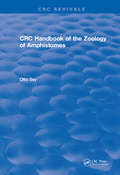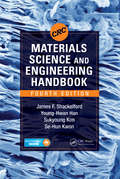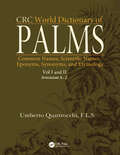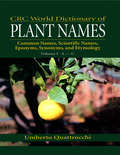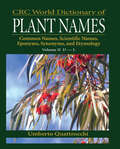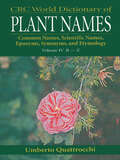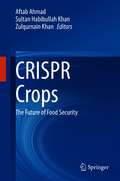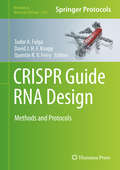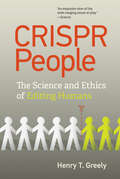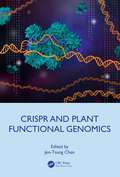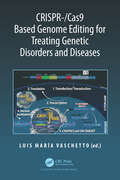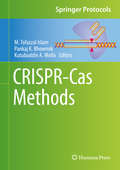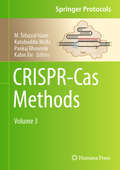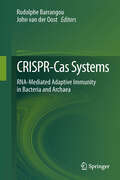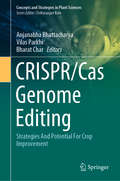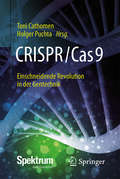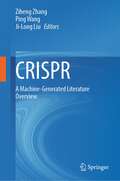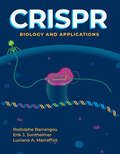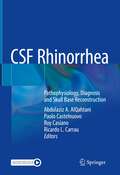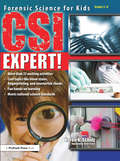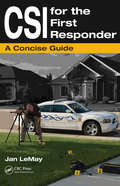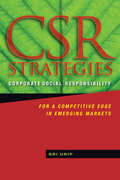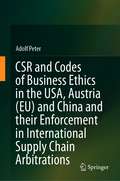- Table View
- List View
CRC Handbook of the Zoology of Amphistomes (CRC Press Revivals)
by Otto SeyHandbook of the Zoology of Amphistomes provides a comprehensive survey on the morphology, ecology, systematics, and zoogeography of amphistomes, which are a group of digenetic trematodes parasitic in vertebrates. The handbook features the special morphological characteristics of amphistomes, including the structure and types of muscular organs; a short diagnosis for each species (when possible), as well as a line drawing of each adult fluke; a zoogeographical analysis, including the host-parasite coevolution, distributional patterns, and characterization of faunas within the zoogeographical realm; and a possible evolutionary scenario based on holomorphological characteristics. Parasitologists, helminthologists, zoologists, and biologists working with ecological associations will find this book an essential reference source for their work with amphistomes.
CRC Materials Science and Engineering Handbook
by James F. Shackelford Young-Hwan Han Sukyoung Kim Se-Hun KwonCRC Materials Science and Engineering Handbook provides a convenient, single-volume source for physical and chemical property data on a wide range of engineering materials. As with the first three editions, this Fourth Edition contains information verified by major professional associations such as ASM International and the American Ceramic Society
CRC World Dictionary of Palms: Common Names, Scientific Names, Eponyms, Synonyms, and Etymology (2 Volume Set)
by Umberto QuattrocchiFrom the Foreword Umberto Quattrocchi has brought us some amazing and useful works through the various dictionaries that he has compiled. This time it is for two very important plant families the palms and the cycads that are synthesized here in these two volumes. Each entry is fascinating not just for the botany and full nomenclature of the plant species but for all the associated uses, folklore and interactions with other organisms. ...These entries are fascinating glimpses of natural history. ... Botanists, conservationists, ethnobotanists, anthropologists, geographers, bird watchers, naturalists, historians and those of many other disciplines will find these volumes a most valuable and useful resource. It is the sort of book that will be in frequent use in my library. ----- Professor Sir Ghillean Prance FRS, VMH, Former Director, Royal Botanic Gardens, Kew Following the same format as Umberto Quattrocchi’s highly praised and well-used previous works, The CRC World Dictionary of Palms: Common Names, Scientific Names, Eponyms, Synonyms, and Etymology brings together the vast and scattered literature on palms and cycads to provide better access to information on these economically important plants. Each genus and species has a detailed morphological description and includes a list of synonyms and vernacular names in many languages. Bibliographies accompany each entry which are comprehensive, up-to-date and multi-lingual. The detailed information for every entry on habitats, economic uses, historical and biographical data, botanical exploration, and linguistics will be useful for any library involved with botany, herbal medicine, pharmacognosy, medicinal and natural product chemistry, ecology, ethnobotany, systematics, general plant science, agriculture or horticulture. Umberto Quattrocchi is the author of the bestselling CRC World Dictionary of Plant Names, winner of the prestigious Hanbury Botanical Garden Award. His most recent multi-volume work, CRC World Dictionary of Medicinal and Poisonous Plants, received strong praise as being "... an unparalleled starting place—a tool of first resort for any thoughtful researcher. Quattrocchi and CRC have delivered a dictionary like no other, a learned finger pointing in the right direction." —John de la Parra, Northeastern University, Boston, Massachusetts, USA, from Economic Botany, Vol. 68, 2014
CRC World Dictionary of Plant Names: Common Names, Scientific Names, Eponyms, Synonyms, and Etymology
by Umberto QuattrocchiA reference covering over 22,000 genre of plants and thousands of species. Included are the botanical names, synonyms, homonyms, and the vernacular and trade names of the commonly accepted generic names.
CRC World Dictionary of Plant Names: Common Names, Scientific Names, Eponyms, Synonyms, and Etymology
by Umberto QuattrocchiThis volume provides the origins and meanings of the names of genera and species of extant vascular plants, with the genera arranged alphabetically from D to L.
CRC World Dictionary of Plant Names: Common Names, Scientific Names, Eponyms. Synonyms, and Etymology
by Umberto QuattrocchiThis volume provides the origins and meanings of the names of genera and species of extant vascular plants, with the genera arranged alphabetically from R to Z.
CRISPR Crops: The Future of Food Security
by Aftab Ahmad Sultan Habibullah Khan Zulqurnain KhanThis book compiles the latest applications of the cutting-edge gene editing tool CRISPR/Cas in the area of crop improvement. It begins with an introduction to the technique and its application in crop plants. Next, it gives an updated overview of available delivery methods, design tools and resources in CRISPR/Cas. The book subsequently reviews the applications of CRISPR/Cas in connection with e.g. insect stress, disease stress, abiotic stress, nutritional and yield improvement in crop plants, etc. It also discusses the various regulatory, ethical and social aspects of the technique that must be kept in mind when designing experiments. In closing, the book summarizes the status quo and outlines future prospects for the tool in crop improvement and food security.Given its scope, the book will especially benefit students and researchers in food science, biotechnology, agriculture and the plant sciences.
CRISPR Guide RNA Design: Methods and Protocols (Methods in Molecular Biology #2162)
by Tudor A. Fulga David J. H. F. Knapp Quentin R. V. FerryThis detailed volume focuses on the CRISPR-associated guide RNA and how it can be designed, modified, and validated for a broad repertoire of purposes. Beginning with a section on computational design of target-specific guide RNAs, the book continues by covering chemical modifications to alter guide RNA stability, specificity, and efficiency, as well as to create inducible guide RNAs, append additional functional domains, and express guide RNAs in a conditional manner. It concludes with methods for measuring off-target guide RNA activity. Written for the highly successful Methods in Molecular Biology series, chapters include introductions to their respective topics, lists of the necessary materials and reagents, step-by-step, readily reproducible protocols, and tips on troubleshooting and avoiding known pitfalls. Authoritative and essential, CRISPR Guide RNA Design: Methods and Protocols provides a comprehensive pipeline for guide RNA design and aims to be an invaluable resource in applying this powerful technology to basic research and therapeutic applications.
CRISPR People: The Science and Ethics of Editing Humans
by Henry T. GreelyWhat does the birth of babies whose embryos had gone through genome editing mean--for science and for all of us?In November 2018, the world was shocked to learn that two babies had been born in China with DNA edited while they were embryos--as dramatic a development in genetics as the cloning of Dolly the sheep was in 1996. In this book, Hank Greely, a leading authority on law and genetics, tells the fascinating story of this human experiment and its consequences. Greely explains what Chinese scientist He Jiankui did, how he did it, and how the public and other scientists learned about and reacted to this unprecedented genetic intervention.
CRISPR and Plant Functional Genomics
by Jen-Tsung ChenCRISPR is a crucial technology in plant physiology and molecular biology resulting in more sustainable agricultural practices, including outcomes of better plant stress tolerance and crop improvement. CRISPR and Plant Functional Genomics explores ways to release the potential of plant functional genomics, one of the prevailing topics in plant biology and a critical technology for speed and precision crop breeding. This book presents achievements in plant functional genomics and features information on diverse applications using the emerging CRISPR-based genome editing technologies producing high-yield, disease-resistant, and climate-smart crops. It also includes theories on organizing strategies for upgrading the CRISPR system to increase efficiency, avoid off-target effects, and produce transgene-free edited crops.Features: Presents CRISPR-based technologies, releasing the potential of plant functional genomics Provides methods and applications of CRISPR/Cas-based plant genome editing technologies Summarizes achievements of speed and precision crop breeding using CRISPR-based technologies Illustrates strategies to upgrade the CRISPR system Supports the UN’s sustainable development goals to develop future climate-resilient crops CRISPR and Plant Functional Genomics provides extensive knowledge of CRISPR-based technologies and plant functional genomics, and is an ideal reference for researchers, graduate students, and practitioners in the field of plant sciences as well as agronomy and agriculture.
CRISPR-/Cas9 Based Genome Editing for Treating Genetic Disorders and Diseases
by Luis María VaschettoThe CRISPR-Cas9 genome-editing system is creating a revolution in the science world. In the laboratory, CRISPR-Cas9 can efficiently be used to target specific genes, correct mutations and regulate gene expression of a wide array of cells and organisms, including human cells. CRISPR-/Cas9 Based Genome Editing for Treating Genetic Disorders and Diseases is a unique reading material for college students, academicians, and other health professionals interested in learning about the broad range of applications of CRISPR/Cas9 genetic scissors. Some topics included in this book are: the role of the CRISPR/Cas9 system in neuroscience, gene therapy, epigenome editing, genome mapping, cancer, virus infection control strategies, regulatory challenges and bioethical considerations.
CRISPR-Cas Methods (Springer Protocols Handbooks)
by M. Tofazzal Islam Pankaj K. Bhowmik Kutubuddin A. MollaThis volume details the fundamentals of the CRISPR-Cas system, and its protocols illustrate advances in CRISPR-Cas techniques for efficient genome editing. Introductory chapters provide a wide horizon of CRISPR/Cas-based methods and applications. Additional chapters guide readers through HDR-mediated editing, sgRNA design, the step-by-step procedure of multiplex adenine base editing experiments in rice, generating mutants for rice, wheat, Brachypodium, Barley, Flax, and Phytophthora, visual screening of mutants, gene deletion (knock-out), tagging (knock-in) in mammalian cells, the cloning-free (DNA-free) technique, cell-penetrating peptides, generating a genome-edited banana, and nuclear genome editing of Chlamydomonas employing CRISPR-Cpf1 combined with a single-stranded DNA (ssODN) repair template. Authoritative and cutting-edge, CRISPR-Cas Methods aims to assist researchers who are new to the field and are aiming to learn how best to adopt this technology for a particular organism.
CRISPR-Cas Methods: Volume 2 (Springer Protocols Handbooks)
by M. Tofazzal Islam Kutubuddin Ali MollaThis second volume provides new and updated methods detailing advancements in CRISPR-Cas technical protocols. Chapters guide readers through protocols on prime editing, base editing, multiplex editing, editing in cell-free extract, in silico analysis of gRNA secondary structure and CRISPR-diagnosis. Authoritative and cutting-edge, CRISPR-Cas Methods, Volume 2 aims to serves as a laboratory manual providing scientists with a holistic view of CRISPR-Cas methodologies and its practical application for the editing of crop plants, cell lines, nematode and microorganism.
CRISPR-Cas Methods: Volume 3 (Springer Protocols Handbooks)
by M. Tofazzal Islam Kutubuddin Molla Pankaj Bhowmik Kabin XieThis third edition expands upon the previous two editions with new and updated methods presenting comprehensive, step-by-step protocols for recently developed techniques that were not included in the earlier volumes. Chapters feature contributions from the globally leading experts in the field, aiming to equip researchers with the practical tools necessary for successful CRISPR experimentation. Authoritative and cutting-edge, CRISPR-Cas Methods, Volume 3 aims to be a useful and practical guide for researches to help further their study in this field.
CRISPR-Cas Systems: RNA-mediated Adaptive Immunity in Bacteria and Archaea
by Rodolphe Barrangou and John van der OostCRISPR/Cas is a recently described defense system that protects bacteria and archaea against invasion by mobile genetic elements such as viruses and plasmids. A wide spectrum of distinct CRISPR/Cas systems has been identified in at least half of the available prokaryotic genomes. On-going structural and functional analyses have resulted in a far greater insight into the functions and possible applications of these systems, although many secrets remain to be discovered. In this book, experts summarize the state of the art in this exciting field.
CRISPR/Cas Genome Editing: Strategies And Potential For Crop Improvement (Concepts and Strategies in Plant Sciences)
by Anjanabha Bhattacharya Vilas Parkhi Bharat CharThis book offers a comprehensive collection of papers on CRISPR/Cas genome editing in connection with agriculture, climate-smart crops, food security, translational research applications, bioinformatics analysis, practical applications in cereals, floriculture crops, engineering plants for abiotic stress resistance, the intellectual landscape, regulatory framework, and policy decisions. Gathering contributions by internationally respected experts in the field of CRISPR/Cas genome editing, the book offers an essential guide for researchers, students, teachers and scientists in academia; policymakers; and public companies, private companies and cooperatives interested in understanding and/or applying CRISPR/Cas genome editing to develop new agricultural products.
CRISPR/Cas9 – Einschneidende Revolution in der Gentechnik
by Holger Puchta Toni CathomenDie Biologie erlebt zurzeit die größte Revolution seit 30 Jahren. Der Auslöser: die molekulare Schere CRIPSR/Cas. Mit ihr ist es möglich, einfach und effizient die genetische Information eines Organismus zu verändern. Das hat weitreichende Konsequenzen für unser aller Leben. In der Landwirtschaft wie in der Medizin werden Dinge machbar, die vor wenigen Jahren noch für unmöglich erachtet wurden: Weizen und Tomaten, die resistent gegen Mehltaubefall sind, und Patienten, die nun die Aussicht haben, ihre tödliche Krankheit zu überleben.In diesem Buch haben wir eine Reihe von allgemeinverständlichen Artikeln zusammengestellt, die in den letzten Jahren in Nature, Spektrum der Wissenschaft, ZEIT und FAZ zu diesem Thema veröffentlicht wurden und die folgenden Fragen beantworten:· Woher kommt CRISPR/Cas und wie funktioniert es?· Wie können wir damit bessere Kulturpflanzen züchten?· Welche Krankheiten können wir damit heilen?· Was sind die Hoffnungen? Was sind die Risiken? · Was ist ethisch vertretbar und wo setzen wir die Grenzen? Sind wir auf dem Weg zum künstlichen Menschen?
CRISPR: A Machine-Generated Literature Overview
by Ping Wang Ziheng Zhang Ji-Long LiuThe book presents a machine-generated literature review on CRISPR (clustered regularly interspaced short palindromic repeats) from 114 selected papers published by Springer Nature in the last few years, which are then organized by the book editors with a human-written introduction to each chapter. Each chapter presents summaries of predefined themes and provides the reader with a basis for further exploration of the topic. As one of the experimental projects initiated by Springer Nature for AI book content generation, this book shows the latest developments in the CRISPR field. It will be a useful reference for graduate students who are interested in CRISPR-related research and early-career researchers who need an overview of the current development of the field.
CRISPR: Biology and Applications (ASM Books #Volume 546)
by Rodolphe Barrangou Erik J. Sontheimer Luciano A. MarraffiniCRISPR CRISPR: BIOLOGY AND APPLICATIONS “An excellent compendium of all things CRISPR from some of the leading minds in the field. With thorough coverage from every angle and beautifully detailed illustrations, this book is not to be missed!” Jennifer A. Doudna, Professor of Chemistry, Biochemistry & Molecular Biology, UC Berkeley; Founder, Innovative Genomics Institute; Nobel Laureate and coinventor of CRISPR technology “This journey through CRISPR biology and several of its breakthrough applications offers an exciting glimpse into one of the most beautiful and compelling fields in the life sciences.” David R. Liu,Director of the Merkin Institute at the Broad Institute of MIT and Harvard; Professor of Chemistry and Chemical Biology at Harvard University; coinventor of base editing and prime editing “A must read! The CRISPR topics, written by world-leading experts, span from the fascinating mechanistic underpinnings to the ingenious applications. One can read from start to finish or pick and choose themes. Either way, the book delivers utterly enjoyable learning!” Bonnie Bassler, Squibb Professor and Chair, Princeton University Department of Molecular Biology; Howard Hughes Medical Institute Investigator CRISPR-Cas systems have revolutionized the science of gene editing and their possible applications continue to expand, from basic research to potentially groundbreaking medical and commercial uses. Led by a distinguished team of editors, CRISPR: Biology and Applications explores the subject matter needed to delve into this fascinating area. Topics covered include: Classification and molecular mechanisms of CRISPR-Cas systems CRISPR-Cas evolution, regulation, expression, and function Uses for gene editing and modulation of gene expression CRISPR-based antimicrobials and phage resistance for medical and industrial purposes Written by internationally renowned authors, CRISPR: Biology and Applications serves as both an introductory guide for those new to the field and an authoritative reference for seasoned researchers whose work touches this evolving and headline- making science.
CSF Rhinorrhea: Pathophysiology, Diagnosis and Skull Base Reconstruction
by Paolo Castelnuovo Roy Casiano Abdulaziz A. AlQahtani Ricardo L. CarrauThis comprehensive book is divided into 6 parts that cover all topics related to cerebrospinal fluid (CSF ) rhinorrea. It provides in-depth theoretical and practical knowledge, and includes teaching material as well as evidence-based scientific content.The introductory part presents the skull base anatomy, CSF physiology, pathophysiology of skull base defects as well as the role of imaging in this condition. The second and third parts provide details of different diagnostic features and conservative management. The fourth and central part thoroughly illustrates surgical approaches for this clinical condition and follows a similar structure, describing each surgical procedure step-by-step. The fifth part sheds light on the postoperative management and the long-term follow up, while the last part addresses miscellaneous topics, such as quality of life, outcome measures, and medico-legal issues. The book is enriched by a wealth of high-quality figures and online videos that illustrate real-world clinical cases, and each chapter features a summary box, key points and a conclusion. The contributors are leading experts in the field and include authorities and inventors of skull base surgical approaches and reconstruction techniques. The multidisciplinary panel of authors – from 6 continents – consists of neurosurgeons, radiologists and anesthesiologists. The book is intended for medical, surgical and paramedic professionals, and is a valuable resource for all levels – from medical students to consultants.
CSI Expert!: Forensic Science for Kids (Grades 5-8)
by Karen K. SchulzCrime scene investigation is hotter than ever, and kids everywhere will love learning about how their favorite detectives use science to figure out unsolvable thefts, arsons, mysteries, and more. CSI Expert!: Forensic Science for Kids includes more than 25 in-depth activities on fingerprinting, evidence collection, blood-stain identification, forensic careers, ballistics, and much more.The author of the best-selling Crime Scene Detective series combines more than a decade of experience teaching forensic science to middle school students with the latest technology and research in criminal investigations in the intriguing standards-based scientific study included in CSI Expert!Students will love collecting dental impressions, studying their classmates' fingerprints, looking at tool marks left at the scene of the crime, analyzing mysterious powders, and discovering the various types of counterfeit checks. Each lesson includes a realistic case for students to crack using the knowledge they've learned about analyzing forensic evidence, and the book also includes an assessment assignment that teachers can employ to test their students' learning.Both kids and teachers will be able to easily implement the book's hands-on, detailed, and exciting forensic science experiments using everyday materials. After completing these activities, kids will be begging for more fun science learning!Grades 5-8
CSI for the First Responder: A Concise Guide
by Jan LeMayCritical to the successful apprehension and prosecution of criminals, the job of collecting evidence at a crime scene requires knowledge, technical skills, patience, and perseverance. Often this task falls on just one individual — the officer on routine patrol duties who is the first to arrive at the scene of a crime. Written by an expert with seventeen years experience in law enforcement, CSI for the First Responder is a succinct guide on how to secure, search, identify, document, collect, and preserve physical evidence essential for solving a case and making the evidence stand up in court.A practical, hands-on resource to all aspects of crime scene investigation, this book covers: The approach to the scene Securing the scene Searching for and identifying evidence Documenting the evidence through notes and reports Photography and videotape Sketches and diagrams Collection and preservation The investigative value of different types of evidence Testimony and presenting evidence in court Enhanced with real-life examples, the book presents case studies implementing the described techniques. The case studies include examples of successful scene security and documentation as well as cautionary tales of erroneous practices with lessons learned. Also included with this book is a Quick Reference Guide on the downloadable resources, which can be downloaded to patrol car laptops or printed and kept in a pocket for easy access. Spanning the entire scope of a case from initial discovery of evidence to courtroom presentation, this one-stop resource enables law enforcement to nail down the evidence they need to prove the crime and get the conviction.
CSR Communication in the Media: Media Management on Sustainability at a Global Level (CSR, Sustainability, Ethics & Governance)
by Lars Rademacher René Schmidpeter Franzisca WederCorporate social responsibility (CSR) is an established management focus of today's companies and organizations of different types, scope and size. Communication practices on CSR and sustainability in the media industry, related theoretical concepts, and empirical foundations have not yet been sufficiently explored. This book focuses on a new normative framework of sustainability, bridging the established debate on public value with the current debate on social impact and the social license to operate in the media industry. With a variety of contributions from theory and practice, the book addresses the dual nature of media and media companies, which simultaneously produce economic and cultural goods and thus bear a "double responsibility": on the one hand, for the way they present reality, monitor and criticize economic and political developments, and bring ethical concerns to the public debate. On the other hand, they bear responsibility for their own activities as companies (license to operate). The book is therefore aimed at readers interested in the journalistic perspective and at executives in the media industry.
CSR Strategies: Corporate Social Responsibility for a Competitive Edge in Emerging Markets
by Sri UripGlobalization has changed the nature of many markets. Previously protected local industries have been forced to become more competitive, a situation that provides both opportunities and challenges. Key among these is the challenge of implementing responsible business practices. Corporate social responsibility (CSR) is widely recognized as a worthy commitment to ensure sustainable benefit for both corporations and communities. CSR is also becoming an important base for businesses to build trust and confidence in their stakeholders, with the potential to provide a competitive edge. To ensure sustainable growth opportunities, companies should pursue the three key dimensional values of creation: Profit People Planet Well defined and strategic CSR activities will ensure an optimum balance between social, environmental, and economic factors for sustainable profits. Hence, CSR has to be embedded within the business strategy to provide a competitive edge in the areas of brand equity, corporate reputation, employee retention, and environmental conservation. Although the principles of CSR are essentially the same globally, each location still calls for different emphasis in the implementation process. Successful application of CSR principles is directly influenced by the business understanding of its business strategy in proportion to the needs of the local community. As someone who has implemented all the above activities successfully, author Sri Urip is well placed to discuss effective CSR strategies to 21st century companies.
CSR and Codes of Business Ethics in the USA, Austria (EU) and China and their Enforcement in International Supply Chain Arbitrations
by Adolf PeterThis book analyzes the implementation of CSR reporting and codes of business conduct and ethics in the legal systems of the USA, Austria and China and their enforcement in international supply chain arbitrations. The book demonstrates that long-term profit maximization is increasingly intertwined with corporate ethics and CSR policies. In order to prevent window-dressing and greenwashing, certain control mechanisms and legal standards are required along the entire supply chain.This book introduces an ethics and CSR system recommending a reward-based whistleblowing mechanism, internal oversight by a CSR and Ethics Committee comprised of independent board members and at least one sustainability expert, and an external, independent and comprehensive assurance of CSR reports provided by auditing firms or newly formed governmental agencies consisting of certified CSR experts.The author emphasizes the significance for supply chain leaders to ensure contractual enforcement of their codes of business ethics and conduct along the supply chain. Against this background, the author created a comprehensive fictitious case scenario covering a supply chain dispute arising from the breach of the supply chain leader’s code of business conduct and ethics by a lower-tier supply chain member. The author acknowledges the fact that in most of the cases the governing law of international supply chain contracts is English law or law based on English law. Thus, the author discusses potential contractual claims for damages arising from a loss of profits caused by a loss of reputation resulting from violations of core provisions of the chain leader’s supplier code of conduct pursuant to English law. As international supply chain disputes usually involve more than two parties, and international arbitration is the ideal means for the resolution of these disputes, the book compares the arbitration rules for consolidations and joinders of some of the most significant international arbitration institutions: SIAC, ICC, AIAC, ICDR, VIAC, CIETAC and HKIAC.The book is directed at legal practitioners, legislators of various jurisdictions, board members of corporations, ethics and compliance officers, academics, researchers and students. It is the author’s main goal that the book serves as an inspirational source for the establishment or the improvement of a corporate ethics and CSR system preventing window-dressing and greenwashing and covering the entire supply chain. Furthermore, it is intended that students develop a deeper understanding for the enforcement of corporate ethics and CSR policies.
